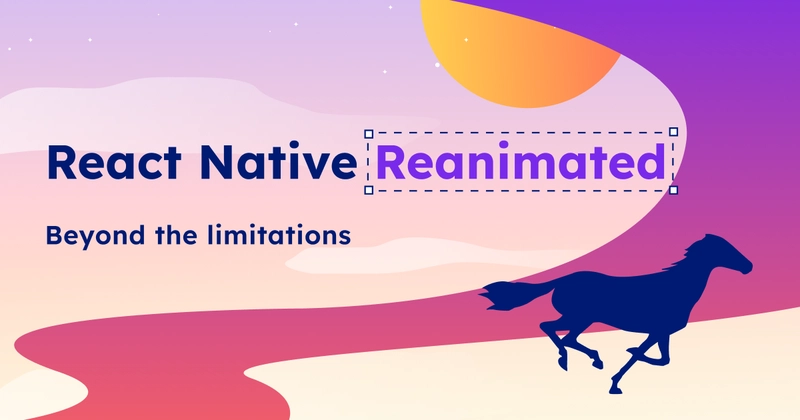React Native has revolutionized mobile app development by enabling cross-platform apps with a single codebase. However, when it comes to smooth, performant animations, developers often face challenges due to JavaScript’s threading limitations. That’s where React Native Reanimated comes in—a game-changing library for building buttery-smooth, 60 FPS animations directly on the native thread.
In this comprehensive guide, we’ll explore React Native Reanimated 3, its core features, benefits, and how to leverage it for high-performance animations in your apps.
🔹 What is React Native Reanimated?
React Native Reanimated is a powerful animation library that allows developers to offload animation logic to the native UI thread, bypassing the JavaScript bridge. This results in:
- Smoother animations (60 FPS even with complex transitions).
- Declarative API for easier animation management.
-
Gesture integration with
react-native-gesture-handler.
With Reanimated 3 (latest version in 2025), the library has introduced new hooks, improved performance, and better debugging tools.
🔹 Why Use Reanimated Instead of Default Animated API?
| Feature | React Native Animated | React Native Reanimated |
|---|---|---|
| Thread | Runs on JS thread (can cause jank) | Runs on Native UI thread (smooth) |
| Performance | Limited by JS bridge | 60 FPS, no bridge bottleneck |
| Declarative Syntax | No | Yes (easier to read & maintain) |
| Gesture Support | Basic | Deep integration with react-native-gesture-handler
|
| Debugging | Limited | Advanced dev tools & logs |
👉 Reanimated is the clear winner for complex, high-performance animations.
🔹 Key Features of React Native Reanimated 3
1. Worklets: Run JavaScript on the Native Thread 🏎️
Worklets allow JavaScript code to execute directly on the native thread, eliminating bridge delays.
javascript
Copy
const opacity = useSharedValue(0);
const fadeIn = () => {
'worklet'; // Marks this function as a worklet
opacity.value = withTiming(1, { duration: 300 });
};
2. Declarative Animations with useAnimatedStyle 🎨
Instead of manually updating styles, use useAnimatedStyle to bind animations to React Native components.
javascript
Copy
const animatedStyle = useAnimatedStyle(() => ({
opacity: opacity.value,
transform: [{ scale: scale.value }],
}));
return <Animated.View style={[styles.box, animatedStyle]} />;
3. Smooth Gesture Animations with react-native-gesture-handler ✋
Reanimated integrates seamlessly with gestures, enabling draggable elements, swipe interactions, and pinch-to-zoom.
javascript
Copy
const panGesture = Gesture.Pan()
.onUpdate((e) => {
translateX.value = e.translationX;
translateY.value = e.translationY;
});
4. Physics-Based Animations (withSpring, withDecay) 🏀
Reanimated supports realistic motion with spring and decay animations.
javascript
Copy
scale.value = withSpring(isPressed ? 0.8 : 1, {
damping: 10,
stiffness: 100,
});
5. Shared Element Transitions (New in Reanimated 3) 🔄
Now you can create seamless transitions between screens, similar to Instagram or Pinterest.
javascript
Copy
<Animated.View sharedTransitionTag="sharedImage" />
🔹 Performance Benchmarks: Reanimated vs. Default Animated
| Scenario | Default Animated | Reanimated |
|---|---|---|
| 60 FPS Animation | ❌ Drops frames | ✅ Smooth |
| Complex Gestures | Laggy | Buttery smooth |
| CPU Usage | High (JS thread) | Optimized (Native thread) |
| Memory Impact | Moderate | Low |
💡 Reanimated is up to 3x faster for complex animations.
🔹 How to Install React Native Reanimated 3
Step 1: Install the Package
bash
Copy
yarn add react-native-reanimated
# or
npm install react-native-reanimated
Step 2: Configure Babel (for Worklets)
Add to babel.config.js:
javascript
Copy
plugins: ['react-native-reanimated/plugin'],
Step 3: Enable Hermes (Recommended for Best Performance)
javascript
Copy
// android/app/build.gradle
project.ext.react = [
enableHermes: true,
]
🔹 Advanced Use Cases & Real-World Examples
1. TikTok-Like Swipeable Feed
javascript
Copy
const onSwipe = Gesture.Pan()
.onEnd((e) => {
if (e.velocityX > 1000) {
// Swipe right animation
x.value = withSpring(screenWidth);
}
});
2. Animated Bottom Sheet
javascript
Copy
const translateY = useSharedValue(screenHeight);
const animatedSheetStyle = useAnimatedStyle(() => ({
transform: [{ translateY: translateY.value }],
}));
3. Instagram Stories Progress Bar
javascript
Copy
const progress = useSharedValue(0);
useEffect(() => {
progress.value = withTiming(1, { duration: 5000 });
}, []);
🔹 Debugging & DevTools
Reanimated 3 comes with improved debugging:
-
react-native-reanimated/devtoolsfor inspecting animations. -
console.loginside worklets (no more silent errors). - Performance monitoring with
useAnimatedReaction.
🔹 Conclusion: Should You Use Reanimated in 2025?
✅ Use Reanimated if:
- You need 60 FPS animations.
- Your app has complex gestures (swipe, drag, pinch).
- You want declarative, maintainable animation code.
❌ Stick with default Animated if:
- You only need simple animations (fade, slide).
- You’re working on a legacy project with no performance issues.
🚀 Reanimated 3 is the future of React Native animations—whether you're building a social media app, game, or e-commerce platform, it ensures smooth, native-like interactions.






Top comments (0)
Some comments may only be visible to logged-in visitors. Sign in to view all comments.